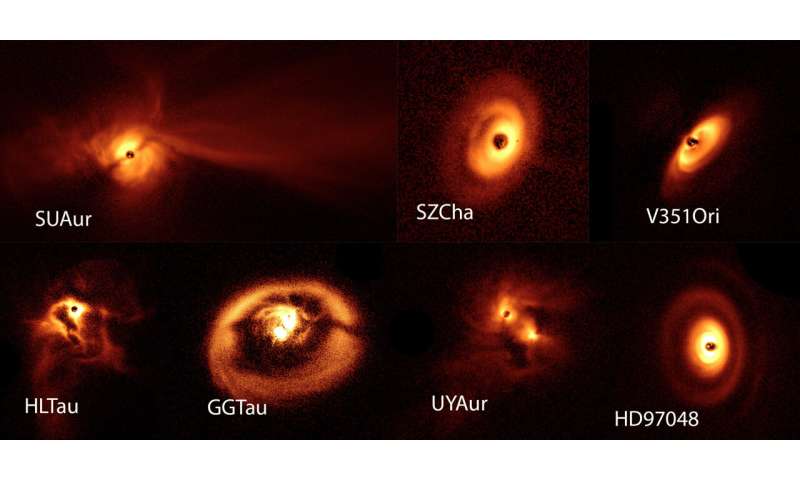Space research sheds new light on formation of planets

An international team of astronomers has shed new light on the fascinating and complex process of planet formation.
Using the European Southern Observatory's Very Large Telescope (ESO's VLT) in Chile, researchers captured stunning images of more than 80 young stars and discs of dust and gas where planets are forming.
The data has been published today in three papers in Astronomy & Astrophysics.
The research represents one of the largest surveys ever of planet-forming discs, providing astronomers with a wealth of data and a treasure trove of imagery and unique insights to help unpick the mysteries of planet formation in different regions of our galaxy.
Dr. Christian Ginski, lecturer at the University of Galway and lead author of one of three new papers published, said, "This is really a shift in our field of study. We've gone from the intense study of individual star systems to this huge overview of entire star-forming regions.
"We know there is a very diverse population of planets out there. Now we know there is a very diverse population of planetary nurseries. Our images help us to try and connect these two, and this will eventually tell us how different kinds of planets are forming. Once we know that we can begin to figure out how often we get something like our own solar system that has the conditions for life to emerge."
The team studied 86 stars across three different star-forming regions of the Milky Way galaxy: Taurus and Chamaeleon I, both around 600 light-years from Earth, and Orion, a gas-rich cloud about 1,300 light-years from us that is known to be the birthplace of several stars more massive than our Sun.
The collection of new images showcases the extraordinary diversity of planet-forming discs in just three, relatively small, regions of our galaxy.
Dr. Ginski describes the imagery captured: "We could call these planetary nurseries—huge discs of gas and dust surrounding young stars. And in terms of the universe, these are in our backyard, as they are only 600-1,300 light years away. Our own Galaxy, the Milky Way, is roughly 80 times as extended. Some of these discs show huge spiral arms, presumably driven by the intricate ballet of orbiting planets."
The observations were gathered by a large international team, with scientists from more than 10 countries.
To date more than 5,000 planets have been discovered orbiting stars other than our Sun, often within systems markedly different from our own solar system. To understand where and how this diversity arises, astronomers must observe the dust- and gas-rich discs that envelop young stars—the very cradles of planet formation. These are best found in huge gas clouds where the stars themselves are forming.
Dr. Ginski added, "We are looking at these young birth places of planets because we want to understand why we are finding so many planetary systems around distant stars that are extremely diverse in their architecture and, mostly, very different from our solar system. To find that answer we turn to the earliest phase of planet formation."

The international research team was able to glean several key insights from the imagery and dataset.
In Orion they found that stars in groups of two or more were less likely to have large planet-forming discs. This is a significant result given that, unlike our Sun, most stars in our galaxy have companions.
As well as this, some of the discs in this region have an asymmetric appearance, suggesting the possibility of massive planets embedded within them, which could be causing the discs to warp and become misaligned.
Across all three star forming regions some imagery shows beautiful structures. Others appear smooth. Others are still interacting with the surrounding birth-cloud of their central star.
In terms of the extraordinary diversity of the planet-formation, some of them are very extended—more than 100 times the distance between the Earth and Sun. In relative terms, some are tiny—maybe 20-30 times the distance between the Earth and Sun, which would be roughly be the orbit of Neptune, the outermost planet in our solar system.
While planet-forming discs can extend for distances hundreds of times greater than the distance between Earth and the Sun, their location several hundreds of light-years from us makes them appear as tiny pinpricks in the night sky.
To observe the discs, the team employed the sophisticated Spectro-Polarimetric High-contrast Exoplanet REsearch instrument (SPHERE) mounted on ESO's VLT.
SPHERE's state-of-the-art extreme adaptive optics system corrects for the turbulent effects of Earth's atmosphere, yielding crisp images of the discs. This meant the team were able to image discs around stars with masses as low as half the mass of the Sun, which are typically too faint for most other instruments available today.
Additional data for the survey were obtained using the VLT's X-shooter instrument, which allowed astronomers to determine how young and how massive the stars are.
The Atacama Large Millimeter/submillimeter Array (ALMA), in which ESO is a partner, on the other hand, helped the team understand more about the amount of dust surrounding some of the stars.
Dr. Ginski added, "The extreme technological advancement in telescopes and instruments over the last decade was really a key factor allowing us to carry out this research. It is amazing that Irish astronomers, as members of ESO, have access to some of the largest telescopes on Earth."
As technology advances, the team hopes to delve even deeper into the heart of planet-forming systems. The large 39-metre mirror of ESO's forthcoming Extremely Large Telescope (ELT), for example, will enable the team to study the innermost regions around young stars, where rocky planets like our own might be forming. The University of Galway is directly contributing to the instrumentation of what will be the biggest telescope on the planet, allowing our astronomers privileged access once it is completed.
Dr. Ginski added, "Once we have the ELT, we will revisit some of the most remarkable systems we have now found in our studies and peer into the regions where future habitable planets will be forming. This will bring us one step closer to understand how life emerges in the Universe."
More information:
www.eso.org/public/news/eso2405/
www.eso.org/public/archives/re … eso2405/eso2405c.pdf
www.eso.org/public/archives/re … eso2405/eso2405b.pdf
www.eso.org/public/archives/re … eso2405/eso2405a.pdf
Provided by University of Galway